Online Exclusives
Journey to the Lost Warships of Midway
Friday, December 01, 2023
From September 8 to 12, 2023, more than 100 researchers from around the world watched as three massive ships—the aircraft carriers Kaga, Akagi, and USS Yorktown—were surveyed on the bottom of the Pacific Ocean. Watch excerpts here from the team’s three 18-hour dives. To see additional images of the ships, click here.
The Assyrian Women of Kanesh
Wednesday, October 11, 2023
This video presents work Assyriologist Cécile Michel of the French National Center for Scientific Research and her colleagues have conducted exploring the lives of Assyrian women who resided in the Bronze Age Anatolian city of Kanesh, about whom you can read in-depth in "Assyrian Women of Letters." Michel has collected translations of more than 300 nineteenth-century B.C. cuneiform tablets by or to women in Women of Assur and Kanesh: Texts from the Archives of Assyrian Merchants. To watch another film exploring her work, go to "Thus Speaks Tarām-Kūbi, Assyrian Correspondence."
A Society's Sacrifice
By JARRETT A. LOBELL
Friday, April 07, 2023
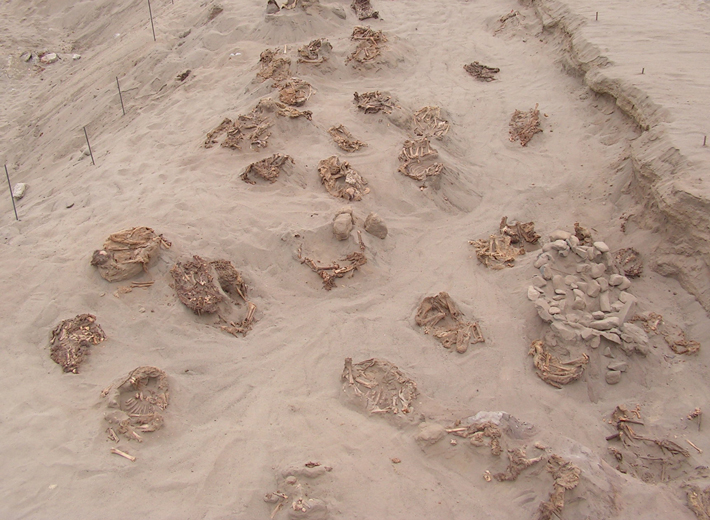 Originally Published January/February 2012
Originally Published January/February 2012
Each year the technology used by archaeologists to locate sites becomes more sophisticated. Satellite images, Google Earth, and ground-penetrating radar are now combined with more traditional methods such as surface surveys and test trenches to determine how and where archaeologists will excavate. But sometimes one of the best sources of information about an area—and one that is frequently overlooked—is the knowledge of the local people who live there and whose families have been there for generations. Such is the case with a site in the small Peruvian coastal town of Huanchaquito that has come to be referred to by the locals as Las Llamas—The Llamas. It is a site that has a great deal to tell about the Andean Chimú culture and their religious and sacrificial practices.
Archaeologist Oscar Gabriel Prieto grew up in the town of Huanchaco, next to Huanchaquito. There, from the time that he was six years old, he would walk around sites in the area. He recently returned to excavate Pampas Gramalote, a small fishing village dating to between 2000 and 1200 B.C. While working there one day in August 2011, Prieto was approached by a resident of Huanchaquito who asked him if he was an archaeologist. When Prieto answered yes, the man said, “Then you have to come with me. Only 300 yards from here, there is another area filled with human bones, including skulls. I know these things are important.”
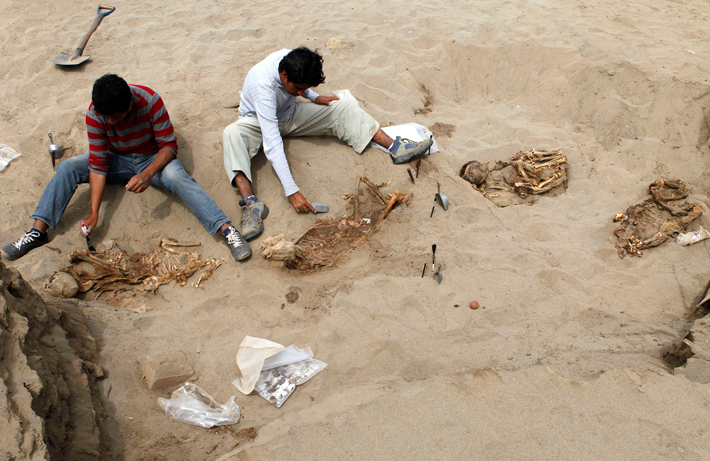
|
Related Feature:
|
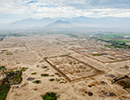
Peru's Great Urban Experiment
|
Where Lions Roamed
Tuesday, August 08, 2023
This map shows the distribution of wild lions from the Pleistocene era through the modern period. The dotted line shows the spread of lions around the world from southern Africa.
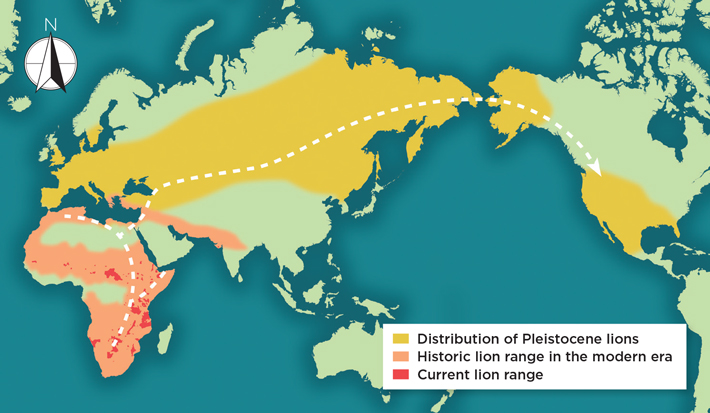
The Enduring Cult of Isis
Friday, October 08, 2021
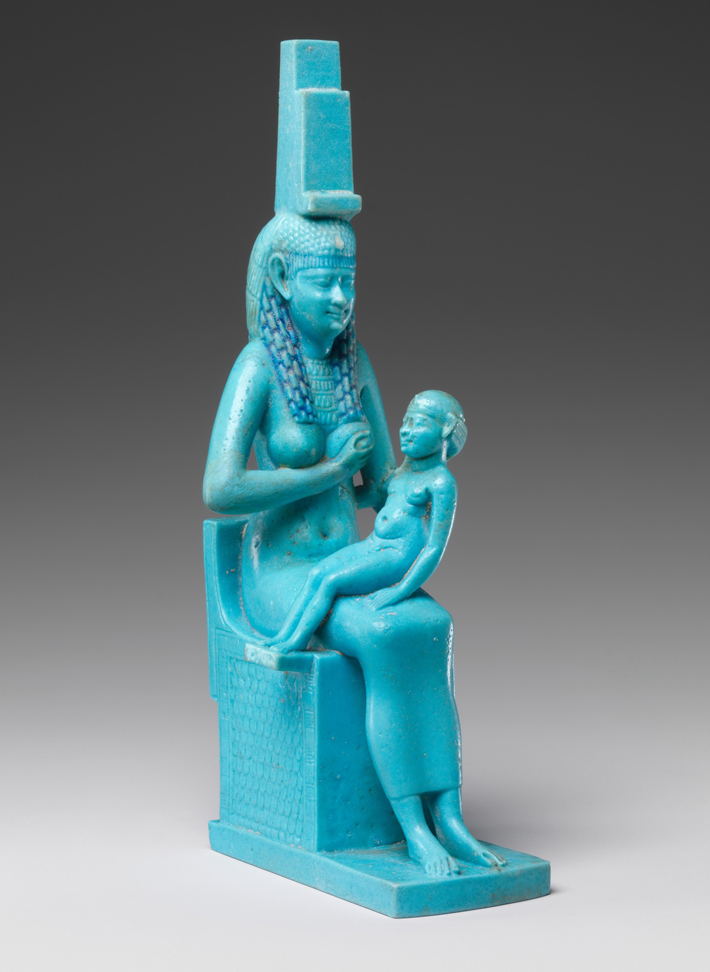 The earliest mention of the Egyptian goddess Isis occurs in the late 5th Dynasty (ca. 2465–2323 B.C.), in the funerary writings known as the Pyramid Texts. As the wife and chief mourner of Osiris, the god of the dead, Isis played a central role in Egyptian, and later Nubian, concepts of royal power and in rites celebrating the dead. As the mother of the god Horus, she was considered the embodiment of perfect motherhood.
The earliest mention of the Egyptian goddess Isis occurs in the late 5th Dynasty (ca. 2465–2323 B.C.), in the funerary writings known as the Pyramid Texts. As the wife and chief mourner of Osiris, the god of the dead, Isis played a central role in Egyptian, and later Nubian, concepts of royal power and in rites celebrating the dead. As the mother of the god Horus, she was considered the embodiment of perfect motherhood.
Though Isis was the most powerful magician and healer among the gods, she did not have her own dedicated temples until late in ancient Egyptian history. Nectanebo II (r. 360–343 B.C.), the last native Egyptian pharaoh, was the first king to commission a temple dedicated to Isis, choosing to build her sanctuary at the site of Behbeit el-Hagar in the Nile Delta. The Macedonian pharaohs of the Ptolemaic Dynasty (305–30 B.C.) dedicated many more to Isis throughout Egypt, including those on the island of Philae.
The worship of Isis at temples in the seaside Ptolemaic capital of Alexandria drew the attention of seafarers from across the Mediterranean. They adopted her as a patron goddess and spread her cult throughout the Greco-Roman world, where she was assimilated with goddesses of fertility such as Demeter and Venus. Outside of Egypt and Nubia, where she retained her queenly status, she eventually lost her association with royal authority. From Britain to Afghanistan, the cult of Isis may have especially appealed to women and slaves.
Temples to Isis were also built across the classical world. One of the best preserved is the Temple of Isis at Pompeii (see “Digging Deeper into Pompeii’s Past”), whose vivid murals depicting the goddess were widely celebrated when they were first unearthed in the eighteenth century. Some scholars believe the temple so impressed Mozart, who visited in 1769, that it heavily influenced the composition of his most mystical opera, The Magic Flute.
As Christianity began to displace the worship of traditional gods throughout the Roman Empire, the cult of Isis also withered, enduring at Philae thanks to the patronage of Nubian royalty. As late as A.D. 452, the Nubian Blemmye people demanded in a treaty with Rome that they continue to be allowed to worship the goddess at the temples of Philae and retain the right to take a sacred statue of Isis to Nubia once a year.
Traditionally, the death knell of the worship of Isis—and ancient Egyptian religion at large—is dated to A.D. 536, when the Byzantine emperor Justinian I (r. A.D. 527–565) sent a military contingent to Philae to arrest the priests of Isis, stamp out pagan worship, and take the island’s treasures back to Constantinople. But the goddess’ presence endured long after the temples at Philae were closed. Indeed, many scholars believe that early images of the Virgin Mary with the baby Jesus were heavily influenced by depictions of Isis nursing the baby Horus.
Advertisement
Advertisement
Advertisement

Recent Issues
-
 May/June 2024
May/June 2024
-
 March/April 2024
March/April 2024
-
 January/February 2024
January/February 2024
-
 November/December 2023
November/December 2023
-
 September/October 2023
September/October 2023
-
 July/August 2023
July/August 2023
-
 May/June 2023
May/June 2023
-
 March/April 2023
March/April 2023
-
 January/February 2023
January/February 2023
-
 November/December 2022
November/December 2022
-
 September/October 2022
September/October 2022
-
 July/August 2022
July/August 2022
-
 May/June 2022
May/June 2022
-
 March/April 2022
March/April 2022
-
 January/February 2022
January/February 2022
-
 November/December 2021
November/December 2021
-
 September/October 2021
September/October 2021
-
 July/August 2021
July/August 2021
-
 May/June 2021
May/June 2021
-
 March/April 2021
March/April 2021
-
 January/February 2021
January/February 2021
-
 November/December 2020
November/December 2020
-
 September/October 2020
September/October 2020
-
 July/August 2020
July/August 2020
-
 May/June 2020
May/June 2020
-
 March/April 2020
March/April 2020
-
 January/February 2020
January/February 2020
-
 November/December 2019
November/December 2019
-
 September/October 2019
September/October 2019
-
 July/August 2019
July/August 2019
-
 May/June 2019
May/June 2019
-
 March/April 2019
March/April 2019
-
 January/February 2019
January/February 2019
-
 November/December 2018
November/December 2018
-
 September/October 2018
September/October 2018
-
 July/August 2018
July/August 2018
-
 May/June 2018
May/June 2018
-
 March/April 2018
March/April 2018
-
 January/February 2018
January/February 2018
-
 November/December 2017
November/December 2017
-
 September/October 2017
September/October 2017
-
 July/August 2017
July/August 2017
-
 May/June 2017
May/June 2017
-
 March/April 2017
March/April 2017
-
 January/February 2017
January/February 2017
-
 November/December 2016
November/December 2016
-
 September/October 2016
September/October 2016
-
 July/August 2016
July/August 2016
-
 May/June 2016
May/June 2016
-
 March/April 2016
March/April 2016
-
 January/February 2016
January/February 2016
-
 November/December 2015
November/December 2015
-
 September/October 2015
September/October 2015
-
 July/August 2015
July/August 2015
-
 May/June 2015
May/June 2015
-
 March/April 2015
March/April 2015
-
 January/February 2015
January/February 2015
-
 November/December 2014
November/December 2014
-
 September/October 2014
September/October 2014
-
 July/August 2014
July/August 2014
-
 May/June 2014
May/June 2014
-
 March/April 2014
March/April 2014
-
 January/February 2014
January/February 2014
-
 November/December 2013
November/December 2013
-
 September/October 2013
September/October 2013
-
 July/August 2013
July/August 2013
-
 May/June 2013
May/June 2013
-
 March/April 2013
March/April 2013
-
 January/February 2013
January/February 2013
-
 November/December 2012
November/December 2012
-
 September/October 2012
September/October 2012
-
 July/August 2012
July/August 2012
-
 May/June 2012
May/June 2012
-
 March/April 2012
March/April 2012
-
 January/February 2012
January/February 2012
-
 November/December 2011
November/December 2011
-
 September/October 2011
September/October 2011
-
 July/August 2011
July/August 2011
-
 May/June 2011
May/June 2011
-
 March/April 2011
March/April 2011
-
 January/February 2011
January/February 2011
Advertisement





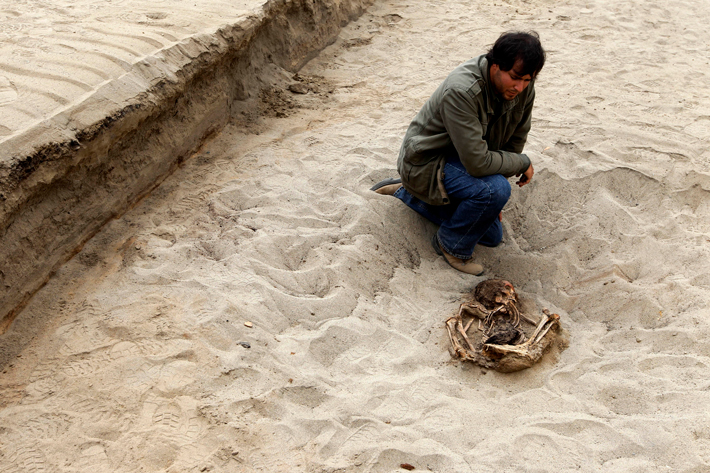 Together they walked to the site and there Prieto saw a number of scattered human skulls and animal bones. No one, save the village’s inhabitants, had ever seen or even known about the site before. Strong Peruvian winter winds had blown away the surface sands and exposed the remains.
Together they walked to the site and there Prieto saw a number of scattered human skulls and animal bones. No one, save the village’s inhabitants, had ever seen or even known about the site before. Strong Peruvian winter winds had blown away the surface sands and exposed the remains.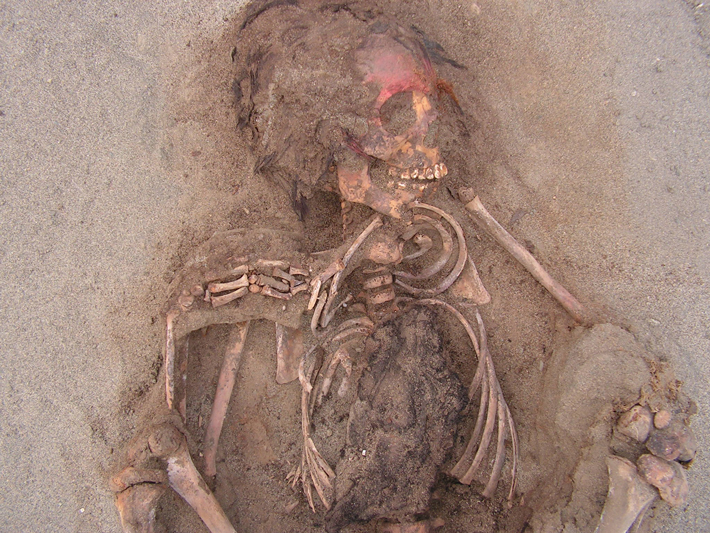 After calling the local archaeological officials and enlisting the services of several of his students from Pampas Gramalote, Prieto quickly got to work. In less than five hours, the team had exposed 20 human bodies and the extremely well-preserved remains of 30 camelids, the family that includes llamas and alpacas. “Right away I realized the magnitude of the discovery,” says Prieto. Shortly thereafter, he was able to add to his team a professional illustrator, a zooarchaeologist, and a physical anthropologist, as well as gather the necessary tools—wheelbarrows, cardboard boxes, shovels, a bit of funding from the town, and a tent to cover the site. Over the next two weeks, under the watchful eyes of the inhabitants of Huanchaquito, Prieto excavated a total of 43 human and 76 llama skeletons. He had uncovered the largest human and animal sacrifice ever found in Peru.
After calling the local archaeological officials and enlisting the services of several of his students from Pampas Gramalote, Prieto quickly got to work. In less than five hours, the team had exposed 20 human bodies and the extremely well-preserved remains of 30 camelids, the family that includes llamas and alpacas. “Right away I realized the magnitude of the discovery,” says Prieto. Shortly thereafter, he was able to add to his team a professional illustrator, a zooarchaeologist, and a physical anthropologist, as well as gather the necessary tools—wheelbarrows, cardboard boxes, shovels, a bit of funding from the town, and a tent to cover the site. Over the next two weeks, under the watchful eyes of the inhabitants of Huanchaquito, Prieto excavated a total of 43 human and 76 llama skeletons. He had uncovered the largest human and animal sacrifice ever found in Peru.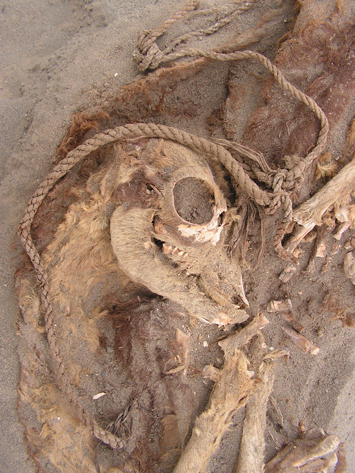 Although the finds at Las Llamas are more extensive than those at any other Andean sacrifice ever identified, this type of ritual event is not unique in the heart of Chimú civilization, according to Prieto. In 1968, as part of a large survey project that first studied the area, archaeologist Christopher Donnan uncovered evidence of a similar event next to the colonial-era church of Huanchaco. There he found 17 children and 20 llamas and concluded that they had been deliberately sacrificed and buried together as part of a Chimú religious ritual. According to Prieto, both children and animals had been part of ritual offerings since the very beginnings of complex societies in the Central Andes. Although at Las Llamas Prieto has found only camelids, at many other sites archaeologists have found remains of parrots, sea birds, monkeys, guinea pigs, and dogs. However, the scale of the Las Llamas find suggests to Prieto that the sacrifice was done for some extraordinary purpose.
Although the finds at Las Llamas are more extensive than those at any other Andean sacrifice ever identified, this type of ritual event is not unique in the heart of Chimú civilization, according to Prieto. In 1968, as part of a large survey project that first studied the area, archaeologist Christopher Donnan uncovered evidence of a similar event next to the colonial-era church of Huanchaco. There he found 17 children and 20 llamas and concluded that they had been deliberately sacrificed and buried together as part of a Chimú religious ritual. According to Prieto, both children and animals had been part of ritual offerings since the very beginnings of complex societies in the Central Andes. Although at Las Llamas Prieto has found only camelids, at many other sites archaeologists have found remains of parrots, sea birds, monkeys, guinea pigs, and dogs. However, the scale of the Las Llamas find suggests to Prieto that the sacrifice was done for some extraordinary purpose.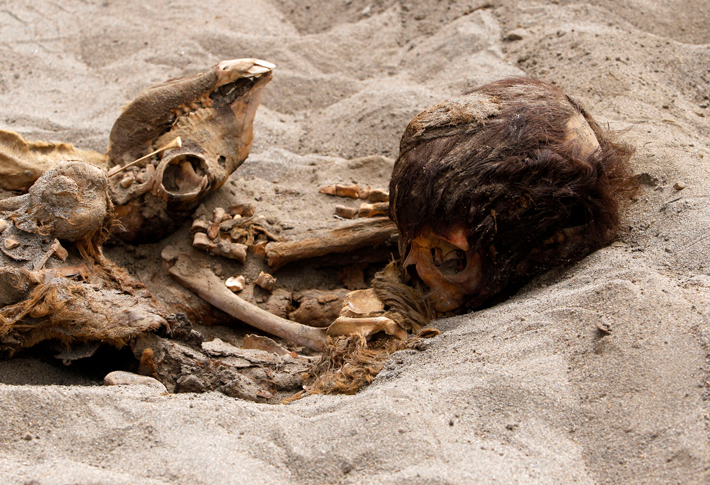 Prieto is in the process of creating a digital site map of the orientation, disposition, and distribution of the children and llamas in order to understand how the sacrifice was organized. For example, some children were buried together with llamas, some with the llamas on top, and some with the llamas underneath. In other cases, the llamas were buried separately. Prieto has established that the burials were organized along east-west and north-south axes, although the significance of these patterns is not yet clear. In the future, the team will undertake analyses of the childrens’ bones and teeth to determine their gender, what kind of diet they had access to, if they belonged to the same genetic group or even the same family, and if they were local or came here from another region. Prieto would also like to know if the llamas were raised locally, or brought in from another area, and if the camelids are exclusively llamas, or if some might be alpacas. There is little evidence for the presence of alpacas on the Peruvian north coast, and alpacas were considered more valuable than llamas. Specialized tests of the children’s hair will determine whether they were poisoned before they were sacrificed and what type of poison may have been used.
Prieto is in the process of creating a digital site map of the orientation, disposition, and distribution of the children and llamas in order to understand how the sacrifice was organized. For example, some children were buried together with llamas, some with the llamas on top, and some with the llamas underneath. In other cases, the llamas were buried separately. Prieto has established that the burials were organized along east-west and north-south axes, although the significance of these patterns is not yet clear. In the future, the team will undertake analyses of the childrens’ bones and teeth to determine their gender, what kind of diet they had access to, if they belonged to the same genetic group or even the same family, and if they were local or came here from another region. Prieto would also like to know if the llamas were raised locally, or brought in from another area, and if the camelids are exclusively llamas, or if some might be alpacas. There is little evidence for the presence of alpacas on the Peruvian north coast, and alpacas were considered more valuable than llamas. Specialized tests of the children’s hair will determine whether they were poisoned before they were sacrificed and what type of poison may have been used.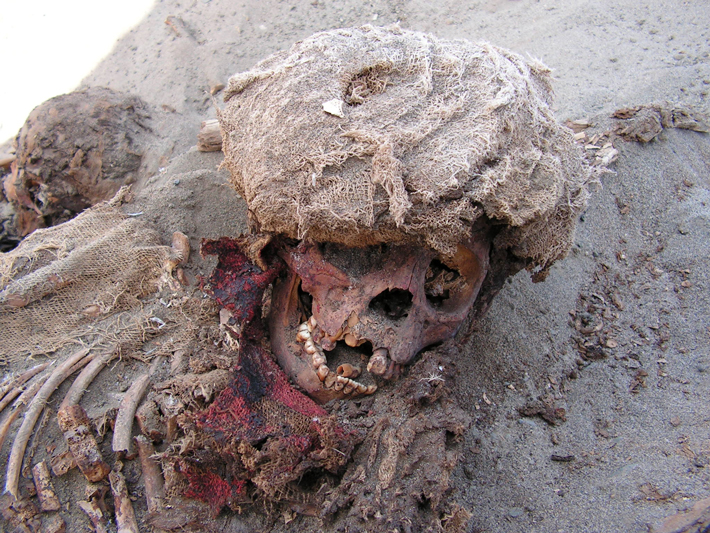 In summer 2012 Prieto’s team will return to Las Llamas to look for more children’s and llamas’ remains. In the meantime, the site is constantly monitored by local guards and the police. And Prieto and his team are always walking around the area to keep it safe from looters and other dangers.
In summer 2012 Prieto’s team will return to Las Llamas to look for more children’s and llamas’ remains. In the meantime, the site is constantly monitored by local guards and the police. And Prieto and his team are always walking around the area to keep it safe from looters and other dangers.
